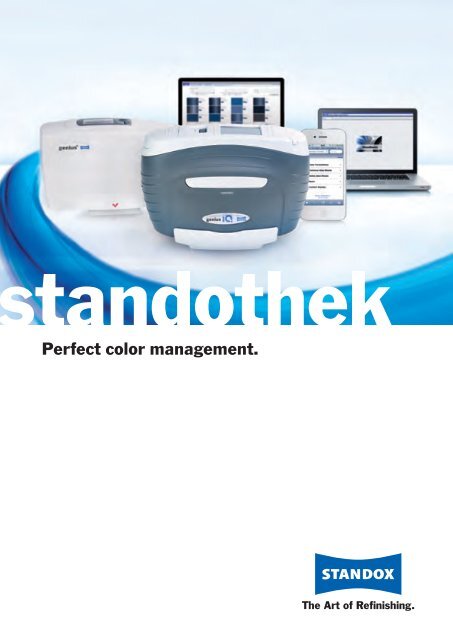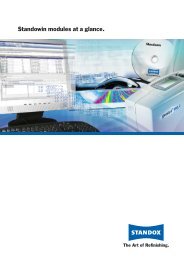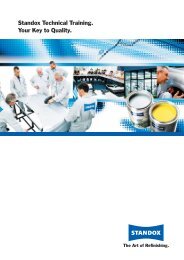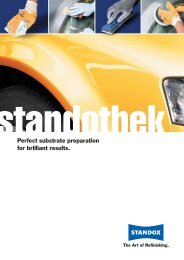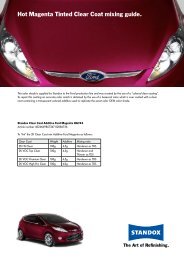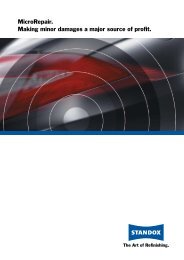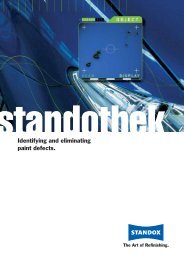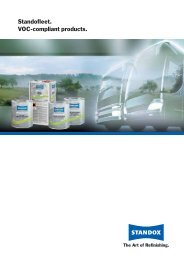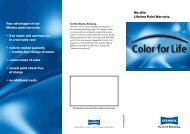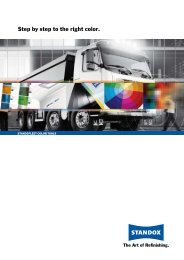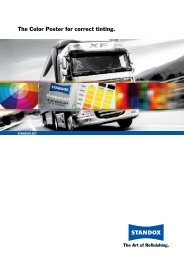Perfect color management. - Standox
Perfect color management. - Standox
Perfect color management. - Standox
You also want an ePaper? Increase the reach of your titles
YUMPU automatically turns print PDFs into web optimized ePapers that Google loves.
tandothek<br />
<strong>Perfect</strong> <strong>color</strong> <strong>management</strong>.
1 Standothek.<br />
Find the right <strong>color</strong> shade.<br />
White is not always white, and<br />
red is not always red. The large<br />
variety of <strong>color</strong>s and nuances<br />
makes it more and more difficult<br />
for the refinisher to find the<br />
right shade.<br />
At the beginning of the 1970s about<br />
7000 <strong>color</strong>s were still enough to<br />
cover the <strong>color</strong> spectrum, today<br />
however there are more than 60 000<br />
shades available at <strong>Standox</strong> alone<br />
and the number is growing every day.<br />
On average 6-7 new <strong>color</strong>s are created<br />
for each car brand each year. Up<br />
to 1000 new <strong>color</strong>s emerge every<br />
year worldwide on our streets, in addition<br />
to their - sometimes numerous<br />
- variants. Hence, the challenges for<br />
refinishers in finding the right <strong>color</strong><br />
and determining the correct mixing<br />
formula are also increasing.<br />
With the constantly increasing number<br />
of mixing formulas, the available<br />
aids and appliances have also been<br />
further developed and substantially<br />
improved. Professional <strong>color</strong> documentation,<br />
electronic <strong>color</strong>-measuring<br />
devices and effective software make<br />
finding <strong>color</strong>s considerably easier.<br />
Despite these modern aids, achieving<br />
a flawless finish depends decisively<br />
on the know-how of the refinisher.<br />
Only if he determines the right <strong>color</strong><br />
will his clients and he himself be<br />
100% satisfied with the paint finish.
2<br />
Contents.<br />
1 Find the right shade.<br />
3 How <strong>color</strong>s are created.<br />
4 A little <strong>color</strong> science.<br />
5 Effect pigments in the automotive industry.<br />
6 The most common effect pigments.<br />
7 - 8 <strong>Perfect</strong> <strong>color</strong> <strong>management</strong> .<br />
9 <strong>Standox</strong> mixing formula.<br />
11 - 12 <strong>Standox</strong> Color Tools at a glance.<br />
13 - 14 Color measurement.<br />
15 - 16 The right mixing formula.<br />
17 - 18 Accurately identifying <strong>color</strong>s.<br />
19 - 20 Color and effect matching.<br />
21 Refinishing.<br />
22 Outlook.<br />
23 Variation description.
3 How <strong>color</strong>s are created.<br />
How <strong>color</strong>s are created.<br />
Have you ever asked yourself<br />
what <strong>color</strong> actually is? Color is a<br />
property of light which originates<br />
through reflection or absorption.<br />
Color is therefore an effect that every<br />
person perceives individually. In order<br />
for this to occur, three things are<br />
needed:<br />
••<br />
Light,<br />
••<br />
a surface which reflects or absorbs<br />
the light,<br />
••<br />
a receptor that absorbs the reflected<br />
light, for example, the eye.<br />
The <strong>color</strong> of a surface is perceived in<br />
its <strong>color</strong>, because it only reflects the<br />
components of the entire light <strong>color</strong><br />
spectrum which correspond to the<br />
<strong>color</strong> of the object.<br />
This means, for example, that a red<br />
surface reflects light of this wavelength<br />
(see also little <strong>color</strong> science) and<br />
„swallows“ (absorbs) the rest.<br />
Exceptions are white and black. In<br />
the case of a white surface, the entire<br />
<strong>color</strong> spectrum of the light is reflected<br />
and we see white. The exact opposite<br />
occurs with black surfaces; the light<br />
is absorbed and the eye perceives<br />
black.<br />
This behaviour is based on the basic<br />
properties of light. Light is an electromagnetic<br />
radiation of different<br />
wavelengths. The visible light can be<br />
represented with a prism in the <strong>color</strong>s<br />
of the rainbow or the spectral <strong>color</strong>s.<br />
Above and below this light component<br />
lies the ultraviolet and infrared range,<br />
which cannot be seen by the human<br />
eye.<br />
Light falls on a red surface. The red <strong>color</strong><br />
component of the <strong>color</strong> spectrum is reflected,<br />
the remaining light is absorbed.<br />
Light falls on a white surface. The complete<br />
<strong>color</strong> spectrum is reflected.<br />
Light falls on a black surface. The complete<br />
<strong>color</strong> spectrum is absorbed.
4<br />
A little <strong>color</strong> science.<br />
Color.<br />
Physically and anatomically justified<br />
sensory impression.<br />
Wavelength.<br />
The wavelength of the electromagnetic<br />
radiation defines visible/invisible<br />
<strong>color</strong>s. The distance between two<br />
neighbouring wave peaks is indicated<br />
in nanometres (nm).<br />
Light.<br />
An electromagnetic radiation in the<br />
wave range between 400 nm (blue)<br />
and 800 nm (red.)<br />
Ultraviolet (UV).<br />
Light with a wavelength < 400 nm.<br />
Infrared (IR).<br />
Light with a wavelength > 800 nm.<br />
Absorption.<br />
The absorption or “swallowing“ of<br />
light by the object.<br />
Reflection.<br />
Counter radiation of light.<br />
Additive <strong>color</strong> mixing.<br />
Addition of light with different wavelengths.<br />
Example: Red and green light<br />
in the same proportion result in yellow<br />
light („TV“ principle).<br />
Spectral <strong>color</strong>s.<br />
All <strong>color</strong>s, which can be perceived<br />
by the human eye in the wavelength<br />
range between 400 nm (blue) and<br />
800 nm (red.)<br />
Primary <strong>color</strong>s.<br />
Red, blue, yellow (see subtractive<br />
<strong>color</strong> mixing).<br />
Subtractive <strong>color</strong> mixing.<br />
All <strong>color</strong>s can be achieved by mixing<br />
the primary <strong>color</strong>s red, blue and<br />
yellow.<br />
Secondary <strong>color</strong>s.<br />
Colors which are created through mixing<br />
the primary <strong>color</strong>s: green, purple,<br />
orange.<br />
Metamerism.<br />
Apparent alikeness of a <strong>color</strong> under<br />
a light source, for example, daylight.<br />
Under a different light source, for<br />
example, street lighting, different <strong>color</strong><br />
impressions emerge.<br />
Transmittance.<br />
Is a measurement unit to determine the<br />
amount of light that is transmitted.<br />
Interference pigments.<br />
Specific effect pigments, for example,<br />
pearl or Xirallic® pigments, the effect<br />
of which is created by the interference<br />
(overlapping) of different effect layers.<br />
Color flop.<br />
The <strong>color</strong> flop is the point at which<br />
the light reflection is reversed at effect<br />
pigments.<br />
This results in <strong>color</strong> changes or<br />
light/dark changes.
5 Effect pigments in the automotive industry.<br />
Effect pigments in the automotive industry.<br />
Effect <strong>color</strong>s are those which<br />
also contain metallic or<br />
pearlescent pigments or other<br />
effect particles besides <strong>color</strong><br />
pigments. If a <strong>color</strong> only contains<br />
<strong>color</strong> pigments, this is called<br />
solid <strong>color</strong> shade.<br />
In the field of car paint, diverse effect<br />
particles are used in order to create<br />
different effects. The refinisher must<br />
therefore adapt the <strong>color</strong> shade<br />
according to the type and quantity of<br />
the effect particles used.<br />
Many varieties are possible from an<br />
iridescent <strong>color</strong> change via metallic<br />
glitter through to a fine pearlescent<br />
shimmer. For special refinishing<br />
(exclusivelineXL) and for the show car<br />
design for individual cars, even more<br />
is possible than in the automotive<br />
serial production.<br />
The number of effect particles is<br />
continuously growing and more and<br />
more possibilities arise in order to<br />
optically change and design a car<br />
through <strong>color</strong>.<br />
Matt finishes in different degrees<br />
of gloss are becoming increasingly<br />
popular in automotive serial coatings.<br />
Color is an important and<br />
comparatively economical resource<br />
for manufacturers to differentiate<br />
themselves and give the car a<br />
particular image.<br />
Effect pigments.<br />
Reflection aluminium pigments: Light is reflected.<br />
Reflection pearlescent pigments: Light is refracted.<br />
The basis of all <strong>color</strong> effects is the interaction between light and material.<br />
The effects arise from:<br />
••<br />
reflection<br />
••<br />
absorption<br />
••<br />
scatter<br />
••<br />
transmission
6<br />
The most common effect pigments.<br />
Silver dollar aluminium<br />
Pearlescent pigments<br />
Cornflake aluminium<br />
Xirallic®<br />
Aluminium pigments.<br />
Aluminium pigments are the most<br />
common effect particles used in the<br />
automotive industry.<br />
They consist of small plates which give<br />
the paint its metallic character. They<br />
are usually silver grey and reflect and<br />
scatter the light. The reflection type<br />
depends on the size of the particles<br />
and the surface finish. Silver dollar<br />
aluminium has a lentoid shape and a<br />
smooth surface, it reflects the light in<br />
a vectored manner; <strong>color</strong>s therefore<br />
shine brighter.<br />
Cornflake aluminium does not scatter<br />
the light as much because of its structured<br />
surface; therefore <strong>color</strong>s appear<br />
paler.<br />
Pearlescent pigments.<br />
Pearlescent pigments have been used<br />
since the 1980s. They use mica flakes<br />
as carriers, which are coated with<br />
different metal oxides. Thin flakes in<br />
different sizes provide the desired<br />
effect.<br />
The effects of the pearlescent pigments<br />
are due to interference, transmission<br />
and absorption.<br />
The flakes themselves are usually<br />
semi-transparent and refractive, which<br />
creates fascinating <strong>color</strong> changes.<br />
Colour and brightness depend upon<br />
the visual angle. In order to obtain an<br />
ideal refinishing result, the pigments<br />
must be aligned in parallel.<br />
Special effects.<br />
The so-called flip-flop pigments are<br />
characterised by a <strong>color</strong> change or<br />
gradient. They also consist of coated<br />
flakes. These have many partially<br />
transparent layers, which glow in a<br />
spectrum of different <strong>color</strong>s depending<br />
on the visual angle and light reflection.<br />
The core of these flakes is non-transparent.<br />
These pigments consist of a very<br />
high <strong>color</strong> brilliance and intensity.
7 Standothek - <strong>Perfect</strong> <strong>color</strong> <strong>management</strong>.<br />
Causes for <strong>color</strong> variations.<br />
Color variations occur in serial<br />
production despite modern test<br />
methods and processes.<br />
••<br />
Many reasons exist for <strong>color</strong> variations<br />
in serial production.<br />
••<br />
Different, worldwide production sites<br />
of the automobile manufacturers,<br />
••<br />
different application procedures,<br />
••<br />
coating chemicals.<br />
Different production sites.<br />
Vehicle manufacturers produce<br />
different models at different sites.<br />
With a wide <strong>color</strong> palette, which is<br />
normally mandatory for all the vehicle<br />
manufacturer‘s vehicles, variations<br />
occur because of different production<br />
conditions at the various production<br />
sites. Among them are, for example,<br />
site-specific application procedures.<br />
Application procedures.<br />
Differences in the application result<br />
from deviating production conditions.<br />
Different results are achieved depending<br />
on how the paint is applied;<br />
manually, coating robot or electrostatically.<br />
Coating chemicals.<br />
The chemistry of the paints also influences<br />
the <strong>color</strong> shade. Depending on<br />
the manufacturing site, solventborne,<br />
waterbased or powder paint is used.<br />
The clearcoats applied also influence<br />
the <strong>color</strong> due to their refractive index.<br />
Therefore, a large number of relevant<br />
factors exist, which favour <strong>color</strong> variations<br />
in serial production.<br />
Manually finishing.<br />
Electrostatic finishing with bell.<br />
Parallel orientation of effect pigments.<br />
Mechanical finishing by robots.<br />
Pneumatic robot finishing.<br />
Random distribution of the effect pigments.
8<br />
Metamerism.<br />
Metamerism describes the optical<br />
phenomenon through which<br />
a <strong>color</strong> changes under different<br />
light sources.<br />
Sometimes a <strong>color</strong> shade (e.g. serial<br />
finishing/refinishing) seems identical<br />
in daylight, though it appears different<br />
under a another light source (e.g.<br />
street lights).<br />
Metamerism occurs due to the<br />
different pigment composition of a<br />
paint. For example, if a green shade is<br />
based purely on green <strong>color</strong> pigments,<br />
while the same green has been mixed<br />
in a different composition with blue<br />
and yellow pigments.<br />
Metamerism can be avoided by exclusively<br />
using pigments for refinishing<br />
which have also been used in serial<br />
coating. The <strong>Standox</strong> <strong>color</strong> formulas<br />
meet these requirements. The corresponding<br />
formulas are tested under<br />
different light sources in the laboratory<br />
before being released. If adjustment<br />
is needed in practice, it is therefore<br />
advisable to use only mixing <strong>color</strong>s<br />
from the given formula.<br />
TIP.<br />
Solar-<strong>color</strong> lamps or fluorescent<br />
tubes, e.g. Osram<br />
L58W/32-965 or Philips<br />
T1-D 58 W/965, work extremely<br />
well to control <strong>color</strong><br />
shades under artificial light.<br />
Color shade in daylight.<br />
Color shade difference under artificial light.
9 <strong>Standox</strong> mixing formula.<br />
From the series <strong>color</strong> to the <strong>Standox</strong><br />
mixing formula.<br />
Color designers must fulfil numerous<br />
technical specifications and meet<br />
high standards when developing new<br />
<strong>color</strong> shades for the automotive serial<br />
production.<br />
New <strong>color</strong> shades should, for<br />
example: match the shape of the car,<br />
harmonise with it or highlight it<br />
••<br />
integrate with the manufacturer‘s<br />
<strong>color</strong> range<br />
••<br />
meet specific pigment requirements<br />
••<br />
meet technical requirements (e.g.<br />
light resistance)<br />
••<br />
comply with calculation specifications.<br />
••<br />
be suitable in serial production<br />
••<br />
be reparable<br />
••<br />
convey individual characteristics<br />
(image)<br />
••<br />
incorporate current fashion trends.<br />
Each new <strong>color</strong> shade formula is also<br />
a challenge for the <strong>Standox</strong> experts.<br />
Despite an extensive formula archive,<br />
a specific formula must be created for<br />
each new shade in order to be able to<br />
reproduce each <strong>color</strong> precisely.<br />
Refinishing paints must also fulfil these<br />
criteria. This is why our products are<br />
always tested under practical conditions.
INFO.<br />
The stability and resistance<br />
of new <strong>color</strong>s is tested under<br />
“Florida weathering“. The<br />
test can last up to three<br />
years.<br />
10
11 <strong>Standox</strong> Color Tools at a glance.<br />
Competence in <strong>color</strong>.<br />
1 Standowin.<br />
2 Genius and Genius IQ.<br />
3<br />
Online <strong>color</strong> search.<br />
With the aid of the approved software,<br />
a <strong>color</strong> shade formula is easy<br />
to find. The large data base contains<br />
<strong>color</strong> shades of all car brands, many<br />
<strong>color</strong> registers and fleet <strong>color</strong>s.<br />
Moreover, under “Color Info“ you<br />
can find many pieces of useful additional<br />
information.<br />
With the measurement devices Genius<br />
and Genius IQ <strong>color</strong>s and their<br />
shades can be measured quickly and<br />
easily directly on the vehicle body.<br />
Genius IQ even recognises the<br />
coarseness of the aluminium<br />
pigments.<br />
You can easily find updated <strong>color</strong><br />
information at any time on your local<br />
<strong>Standox</strong> website.<br />
www.standox.com<br />
3<br />
1<br />
2
12<br />
3<br />
Mobile App.<br />
With the right App for your Smartphone<br />
or tablet PC you can quickly<br />
obtain the latest formula in the paintmixing<br />
area without being connected<br />
to the Internet.<br />
3<br />
2
13 Color measurement.<br />
Genius & Genius IQ.<br />
Genius.<br />
••<br />
Ergonomic design.<br />
••<br />
Solid housing.<br />
••<br />
Good grip.<br />
••<br />
Simple control button.<br />
••<br />
Display, 128 x 64 dots.<br />
••<br />
Operation via thumbwheel.<br />
••<br />
User-friendly menu navigation.<br />
••<br />
Easy to calibrate.<br />
••<br />
Reliable measurement due to 3 “contact pins.“<br />
••<br />
High light output through LED technology (16 LEDs).<br />
••<br />
Internal memory for measurement data.<br />
••<br />
Consideration of the grain addition of the effect<br />
navigator.<br />
See and experience the difference on:<br />
www.standox.de/godigital<br />
Genius IQ.<br />
••<br />
Automatic measurement of the grain of aluminium<br />
pigments.<br />
••<br />
Modern design.<br />
••<br />
Stable housing.<br />
••<br />
High-quality handling.<br />
••<br />
Large and secure control button.<br />
••<br />
TFT <strong>color</strong> display with protective film.<br />
••<br />
Operation via touch screen with stylus or thumbwheel.<br />
••<br />
Easy to use supported by an intuitive graphical user<br />
interface.<br />
••<br />
Pre-selection of car brands directly at the device.<br />
••<br />
Internal memory for data, such as the car brand list<br />
and further information.<br />
••<br />
Optimal positioning for reliable measurements on a<br />
flat surface through 4 “contact pins“.<br />
••<br />
100% protection against scattered light due to additional<br />
rubber ring at the measurement port.<br />
••<br />
Additionally optimised LED technology (20 LEDs) for<br />
an even better light output.
14 12<br />
Finding the right <strong>color</strong> shade quickly and effectively<br />
with Genius.<br />
With Genius <strong>color</strong>s are reliably<br />
and effectively measured directly<br />
on the vehicle.<br />
To determine <strong>color</strong>s in a quick, reliable<br />
and efficient manner; electronic<br />
<strong>color</strong> measurement with Genius is<br />
a must. In the future automobile manufacturers<br />
could increasingly decide<br />
to eliminate <strong>color</strong> coding completely.<br />
Determining <strong>color</strong> would then become<br />
more difficult for independent<br />
paint workshops.<br />
Genius helps to identify all relevant pieces<br />
of information on <strong>color</strong> shades in<br />
a quick and simple way with a handy<br />
and reliable measurement device.<br />
The <strong>color</strong> is determined directly on a<br />
previously polished (only in the case<br />
of gloss varnish) even area as close<br />
to the damage as possible. Genius<br />
reliably identifies both solid and effect<br />
<strong>color</strong>s. The results of this 3-angle measurement<br />
device are extremely precise.<br />
The measurement data is transformed<br />
directly into a finished and, if necessary,<br />
corrected mixing formula with the<br />
software Standowin.<br />
Genius especially shows its strengths<br />
when dealing with difficult <strong>color</strong>s such<br />
as serial-specific variations, rare or<br />
varied <strong>color</strong>s.<br />
Additional useful tips can be found on<br />
the following info posters:<br />
Genius.<br />
••<br />
7 tips for good measurement results<br />
••<br />
8 steps to optimum measurement<br />
results<br />
Genius IQ.<br />
••<br />
6 steps to optimum measurement<br />
results
15 The right mixing formula.<br />
The way to the right mixing formula.<br />
As is generally known, many<br />
roads lead to the same results.<br />
Therefore, <strong>Standox</strong> offers<br />
numerous aids that offer effective<br />
support in searching for formulas.<br />
Standowin.<br />
Standowin has many functions which<br />
make daily tasks easier. With this<br />
software you will always have access<br />
to the latest <strong>color</strong> formulas. You can<br />
search for a formula based on a<br />
previously determined coding or on<br />
the Genius measurement results. When<br />
using Genius, Standowin analyses the<br />
measurement data and suggests the<br />
formulas from the database which best<br />
meet the measured <strong>color</strong>. After the selection<br />
of the right formula, the mixing<br />
formula is corrected automatically on<br />
the basis of the measured data.<br />
The data obtained can be transferred<br />
directly to a connected electronic<br />
scale indicating the precise required<br />
quantity. Suggestions for the required<br />
material quantities can also be<br />
retrieved. Customer-specific formulas<br />
or identified nuances can be saved in<br />
order to have access to them at any<br />
time. In addition to the <strong>color</strong>-formula<br />
search, Standowin offers additional<br />
brand-specific information under the<br />
category „Color Information“ for<br />
example <strong>color</strong> information of add-on<br />
parts or coding positions.<br />
Formula search via the Internet.<br />
Finding the right <strong>color</strong> online: Go to<br />
your national <strong>Standox</strong> website. From<br />
there go to „Online <strong>color</strong> search“.<br />
Here you can find daily-updated<br />
mixing formulas.
17 Accurately identifying <strong>color</strong>s.<br />
Color matching with the blending technique.<br />
Farbcodierung<br />
Refinishing always starts with<br />
identifying the right <strong>color</strong> shade.<br />
Identifying the coding.<br />
Finding the coding is usually like a<br />
“treasure hunt“, since each automobile<br />
manufacturer mounts the type<br />
plates at a different place in the vehicle.<br />
You can find useful information on<br />
possible locations under Color Info in<br />
Standowin.<br />
Polish the paint surface.<br />
Clean and polish the paint surface<br />
next to the damage.<br />
Visual comparison.<br />
Color shade variations are shown in<br />
the Color Box. Compare the <strong>color</strong><br />
sample of the <strong>color</strong> matching fan<br />
close to the damage in order to identify<br />
the <strong>color</strong> shade. The area close to<br />
the damage is extremely important,<br />
since the bodywork could have already<br />
been repainted on other areas.<br />
Problems with the coding.<br />
It could happen that<br />
••<br />
<strong>color</strong> codings are missing, incomplete<br />
or incorrect, or<br />
••<br />
code numbers have been changed<br />
at the factory. This happens when<br />
contrasting <strong>color</strong>s for attachment<br />
parts or <strong>color</strong>s for the interior are<br />
also coded.<br />
There are many options available to<br />
identify the right <strong>color</strong> in these cases:<br />
••<br />
use additional pieces of information<br />
provided by Standowin in the category<br />
“Color Information“.<br />
••<br />
the <strong>Standox</strong> Internet <strong>color</strong> search<br />
offers daily-updated information.<br />
••<br />
measure the <strong>color</strong> with the <strong>color</strong><br />
measurement device “Genius“.<br />
If you still have not identified the right<br />
<strong>color</strong>, you can call the <strong>color</strong>istic experts<br />
on the <strong>Standox</strong> Color hotline.
18<br />
Preparing sample panels.<br />
It is best to prepare two sample panels<br />
with the identified <strong>color</strong>. Paint both<br />
panels as usual. Add a half coat<br />
(finish coat) on the wet basecoat on<br />
the second panel. After drying, the<br />
clearcoat is applied. With the finish<br />
coat, the effect pigments are deposited<br />
on the surface and the <strong>color</strong> appears<br />
lighter.<br />
If possible, carry out the corresponding<br />
<strong>color</strong> test during daylight (northern<br />
light) or with the aid of daylight<br />
lamps from several angles in order to<br />
correctly evaluate the changing and<br />
flop effect in the case of metallic or<br />
pearlescent <strong>color</strong>s.<br />
TIP.<br />
••<br />
Always correctly label and file<br />
<strong>color</strong> samples immediately.<br />
••<br />
Store the data in Standowin.<br />
••<br />
In the case of special paint, it is<br />
recommended to prepare 3 <strong>color</strong><br />
sample panels.
19 Color and effect matching.<br />
Color and effect matching with the blending<br />
technique.<br />
Sometimes the result is not as expected<br />
despite complex nuances and<br />
optimal workshop conditions.<br />
Clearly visible areas at one level (e.g.<br />
wing, door, side panel) are typical<br />
“traps“, particularly when there are no<br />
beading attachment parts or if there is<br />
only a narrow clearance between the<br />
new and the old paintwork.<br />
Here the blending technique is<br />
suitable, which is also recognised by<br />
insurance companies. This enables the<br />
alignment of small <strong>color</strong> differences<br />
between new and old paintwork.<br />
A data sheet to improve solid and effect<br />
paintwork, published for the trade<br />
and insurance companies by BFL, ZKF<br />
and other relevant associations, describes<br />
the techniques and procedures.<br />
Blending is described there in detail.<br />
The data sheet can be accessed under<br />
www.farbe.de and www.zkf.de.<br />
Identifying repair costs/Profitability.<br />
Taking today as a starting point and<br />
looking at future trends of the paint<br />
industry, it is important to take into account<br />
different factors while preparing<br />
a budget for the client in order to guarantee<br />
profitability and effectiveness<br />
for the refinisher and the customer.<br />
The following factors should be taken<br />
into account in establishing the price<br />
and the refinishing cost:<br />
1. Does the paint need several coats<br />
such as a 3-coat structure?<br />
2. Does the <strong>color</strong> present any special<br />
features such as a tinted or<br />
matt clearcoat?<br />
3. Is a special base <strong>color</strong>/filler<br />
needed?<br />
4. Has the vehicle been resprayed<br />
or received a special finish?<br />
This checklist should be completed as<br />
a routine before calculating the costs<br />
and the materials for the refinishing, in<br />
order to avoid misunderstandings with<br />
the customer as well as unexpected<br />
complications during the work.<br />
Clearcoat<br />
Effectcoat<br />
(Pearlescent Pigments)<br />
Solid Color Groundcoat<br />
Filler
20<br />
Blending within a vehicle part.<br />
Step 1.<br />
Apply Standoblue Color Blend in<br />
thin closed coats on the surrounding<br />
surface of the area to be blended or<br />
on the adjacent body part.<br />
Step 2.<br />
Blend the first coating of Standoblue<br />
Basecoat up to the edge of the<br />
Standoblue Color Blend or in the adjacent<br />
area/the adjacent part. Apply<br />
the effect coating and blend it into the<br />
wet Standoblue Color Blend<br />
Step 3.<br />
Apply the Standoblue Basecoat as<br />
normal with 1.5 coatings on the area<br />
to be repaired (filler).<br />
(Pressure 1.5-2.0 bar.)<br />
Step 4.<br />
Apply a <strong>Standox</strong> VOC<br />
clearcoat after drying.
21 Refinishing.<br />
Professional refinishing using professional<br />
products.<br />
<strong>Standox</strong> is one of the worldwide<br />
leading manufacturers for automobile<br />
refinishing paints and offers<br />
high-quality and eco-friendly<br />
product systems for modern<br />
bodyshops.<br />
The quality of a refinish depends on<br />
the right <strong>color</strong> shade. For this purpose,<br />
we offer sound product systems for<br />
each application area, which guarantee<br />
a perfect refinish.<br />
Our products do not only comply<br />
with the EU environmental regulations<br />
but must meet all required properties<br />
around the world. Moreover, whenever<br />
possible, we refrain from using<br />
noxious components, even if their use<br />
were permitted. Our products shine<br />
through their high user-friendliness and<br />
great efficiency. <strong>Standox</strong> ensures efficient<br />
products are always available with<br />
a broad range of customised products<br />
that is constantly being supplemented<br />
and improved.<br />
The quality and standards of our<br />
products are reflected in the large<br />
number of approvals we obtain<br />
from automobile manufacturers. Our<br />
independent bodyshop customers also<br />
take advantage of this.<br />
Numerous aids and practice-oriented<br />
training ensure that you are always<br />
up-to-date.<br />
Training.<br />
The continuously increasing<br />
complexity of <strong>color</strong>s and the<br />
higher quality of materials<br />
place tougher demands on the<br />
refinisher.<br />
<strong>Standox</strong> therefore offers a specific<br />
<strong>color</strong>istic seminar for refinishers,<br />
in addition to many other training<br />
courses. Everything you need to know<br />
about <strong>color</strong> is taught in this targetoriented<br />
training course in theory and<br />
in practice.<br />
Further information is available from<br />
your <strong>Standox</strong> technical advisor.
22<br />
Outlook.<br />
The automotive and paint industry<br />
is guided by international<br />
trends from a variety of areas.<br />
Color, design, shape and materials<br />
play an important role. It may<br />
be true that the trends are not<br />
as fast moving and volatile as in<br />
other industries, but they do last<br />
longer.<br />
Again and again, automobile<br />
manufacturers try to catch attention<br />
with unusual <strong>color</strong>s and effects. The<br />
paint manufacturer and obviously the<br />
refinisher must be able to adapt and<br />
react flexibly. This means that the right<br />
solutions have to be available for<br />
paintwork as well as for refinishing.<br />
Different tendencies and trends, which<br />
will certainly endure over the coming<br />
years, have existed for some time now.<br />
Colors like white, orange and different<br />
shades of brown are now well-established.<br />
Altogether, an increasing trend to<br />
see more <strong>color</strong> is predicted. The silver<br />
era is over. Even though, the worldwide<br />
undisputed bestsellers black, white,<br />
silver and grey are no representatives<br />
of <strong>color</strong>.<br />
New technologies are also gaining<br />
more ground and are appearing<br />
more often. Talk is about the socalled<br />
Tricoats (3-coat structure with<br />
a transparent effect layer on top of<br />
the basecoat) or Tinted Clearcoat<br />
(<strong>color</strong>, tinted clearcoat.) These trends<br />
are mainly coming from Asia and the<br />
USA, where they have already been<br />
well-established for many years.<br />
The so-called liquid-metal shades,<br />
which make a car look like it is made<br />
of steel or chrome, are also in the<br />
limelight for designers at automotive<br />
manufacturers. Special series are<br />
already present in the market. A persistent<br />
trend is also the matt clearcoat,<br />
whether applied to attachment parts<br />
or the entire body. The velvet look of<br />
the surface induces us to touch the car<br />
and grants the <strong>color</strong>s a completely<br />
new appearance.<br />
These more complex <strong>color</strong>s and<br />
technologies mean that: paint<br />
manufacturers and refinishers must be<br />
prepared and have solutions ready for<br />
when these trends start conquering the<br />
streets.<br />
<strong>Standox</strong> accepts these challenges and<br />
offers practice-oriented solutions.<br />
The right advice, the necessary aids<br />
and target-oriented training on a variety<br />
of topics guarantee the refinisher<br />
support.<br />
Cars would not be half as attractive<br />
without the creative art of painting<br />
with all its <strong>color</strong>s and possibilities. As<br />
competent experts, refinishers master<br />
their craft and are aware of how to<br />
manage the interplay between <strong>color</strong><br />
and material in order to make our cars<br />
look new, individual, perfect or even<br />
exclusive. We, at <strong>Standox</strong>, support<br />
you with the best means, because<br />
there is only one thing standing as<br />
always in the foreground: the art of<br />
refinishing.
23 Variation description.<br />
Variation description.<br />
Brown Yellow Blue Green Grey Red<br />
BR GE BL GN GR R<br />
BR+ GE+ BL+ GN+ GR+ R+<br />
BR- GE- BL- GN- GR- R-<br />
BR.D GE.H BL.D GN.D GR.D R.D<br />
BR.D+ GE.H+ BL.D+ GN.D+ GR.D+ R.D+<br />
BR.D- GE.H- BL.D- GN.D- GR.D- R.D-<br />
BR.H GE.D BL.H GN.H GR.H R.H<br />
BR.H+ GE.D BL.H+ GN.H+ GR.H+ R.H+<br />
BR.H- GE.D- BL.H- GN.H- GR.H- R.H-<br />
BR.GB GE.GB BL.GB GN.GB GR.GB R.GB<br />
BR.GB+ GE.GB+ BL.GB+ GN.GB+ GR.GB+ R.GB+<br />
BR.GB- GE.GB- BL.GB- GN.GB- GR.GB- R.GB-<br />
BR.FN GE.FN BL.FN GN.FN GR.FN R.FN.<br />
BR.FN+ GE.FN+ BL.FN+ GN.FN+ GR.FN+ R.FN.+<br />
BR.FN- GE.FN- BL.FN- GN.FN- GR.FN+ R.FN.+<br />
Dark Pale Light Bright Coarse Fine Matt<br />
D F H L GB FN Matt<br />
D+ GE+ BL+ GN+ GR+ R+<br />
D- GE- BL- GN- GR- R-<br />
Service formulas are marked by writing “S!“ before the variation name.<br />
For example:<br />
S! R S! BL.D<br />
S! GN S! GE.FN
TIP.<br />
For additional information, please visit our website:<br />
www.standox.com<br />
24
<strong>Standox</strong> GmbH P.O. Box D-42271 Wuppertal Germany<br />
s


